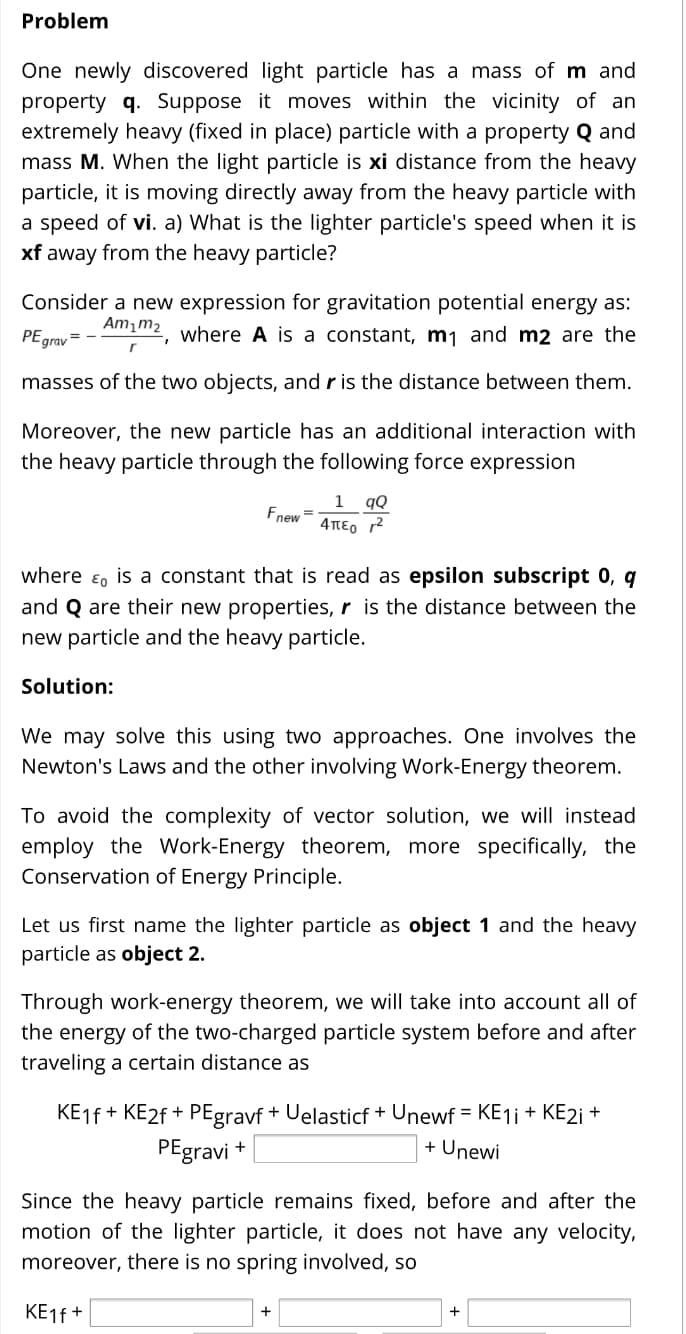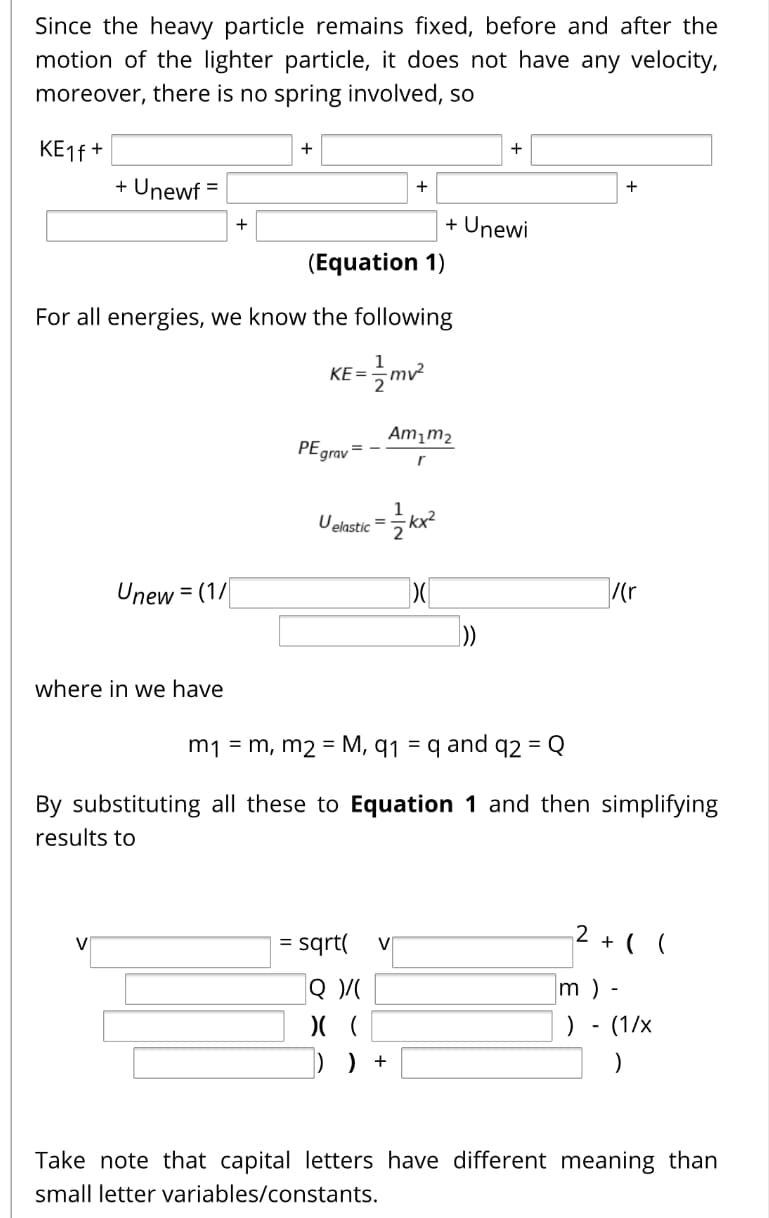Since the heavy particle remains fixed, before and after the motion of the lighter particle, it does not have any velocity, moreover, there is no spring involved, so KE16 + + + Unewf = + + + Unewi + (Equation 1) For all energies, we know the following KE= Am,m2 PEgrav r Uelastic = Unew = (1/ /(r where in we have m1 = m, m2 = M, q1 = q and q2 = Q By substituting all these to Equation 1 and then simplifying results to sqrt( 2 + ( ( %3D V m ) - ) - (1/x Take note that capital letters have different meaning than small letter variables/constants.
Since the heavy particle remains fixed, before and after the motion of the lighter particle, it does not have any velocity, moreover, there is no spring involved, so KE16 + + + Unewf = + + + Unewi + (Equation 1) For all energies, we know the following KE= Am,m2 PEgrav r Uelastic = Unew = (1/ /(r where in we have m1 = m, m2 = M, q1 = q and q2 = Q By substituting all these to Equation 1 and then simplifying results to sqrt( 2 + ( ( %3D V m ) - ) - (1/x Take note that capital letters have different meaning than small letter variables/constants.
Principles of Physics: A Calculus-Based Text
5th Edition
ISBN:9781133104261
Author:Raymond A. Serway, John W. Jewett
Publisher:Raymond A. Serway, John W. Jewett
Chapter9: Relativity
Section9.7: Relativistic Energy
Problem 9.6QQ: The following pairs of energiesparticle 1: E, 2E; particle 2: E, 3E; particle 3: 2E, 4Erepresent the...
Related questions
Topic Video
Question
100%
One newly discovered light particle has a mass of m and property q. Suppose it moves within the vicinity of an extremely heavy (fixed in place) particle with a property Q and mass M. When the light particle is xi distance from the heavy particle, it is moving directly away from the heavy particle with a speed of vi. a) What is the lighter particle's speed when it is xf away from the heavy particle?

Transcribed Image Text:Problem
One newly discovered light particle has a mass of m and
property q. Suppose it moves within the vicinity of an
extremely heavy (fixed in place) particle with a property Q and
mass M. When the light particle is xi distance from the heavy
particle, it is moving directly away from the heavy particle with
a speed of vi. a) What is the lighter particle's speed when it is
xf away from the heavy particle?
Consider a new expression for gravitation potential energy as:
Am m2
PE grav =
where A is a constant, mj and m2 are the
masses of the two objects, and r is the distance between them.
Moreover, the new particle has an additional interaction with
the heavy particle through the following force expression
1
Fnew =
qQ
4περ r2
where ɛ, is a constant that is read as epsilon subscript 0, q
and Q are their new properties, r is the distance between the
new particle and the heavy particle.
Solution:
We may solve this using two approaches. One involves the
Newton's Laws and the other involving Work-Energy theorem.
To avoid the complexity of vector solution, we will instead
employ the Work-Energy theorem, more specifically, the
Conservation of Energy Principle.
Let us first name the lighter particle as object 1 and the heavy
particle as object 2.
Through work-energy theorem, we will take into account all of
the energy of the two-charged particle system before and after
traveling a certain distance as
KE1F + KE2F + PEgravf + Uelasticf + Unewf = KE1 + KE2¡ +
PEgravi +
+ Unewi
Since the heavy particle remains fixed, before and after the
motion of the lighter particle, it does not have any velocity,
moreover, there is no spring involved, so
KE1F +
+

Transcribed Image Text:Since the heavy particle remains fixed, before and after the
motion of the lighter particle, it does not have any velocity,
moreover, there is no spring involved, so
KE16 +
+
+
+ Unewf =
%3D
+
+
+ Unewi
+
(Equation 1)
For all energies, we know the following
KE=
Am¡m2
PEgrav
Uelastic =
Unew = (1/
%3D
where in we have
m1 = m, m2 = M, q1 = q and q2 = Q
By substituting all these to Equation 1 and then simplifying
results to
sqrt(
2 + ( (
|Q
m ) -
(1/x
-
) +
Take note that capital letters have different meaning than
small letter variables/constants.
Expert Solution
This question has been solved!
Explore an expertly crafted, step-by-step solution for a thorough understanding of key concepts.
Step by step
Solved in 2 steps

Knowledge Booster
Learn more about
Need a deep-dive on the concept behind this application? Look no further. Learn more about this topic, physics and related others by exploring similar questions and additional content below.Recommended textbooks for you

Principles of Physics: A Calculus-Based Text
Physics
ISBN:
9781133104261
Author:
Raymond A. Serway, John W. Jewett
Publisher:
Cengage Learning

College Physics
Physics
ISBN:
9781938168000
Author:
Paul Peter Urone, Roger Hinrichs
Publisher:
OpenStax College

Classical Dynamics of Particles and Systems
Physics
ISBN:
9780534408961
Author:
Stephen T. Thornton, Jerry B. Marion
Publisher:
Cengage Learning

Principles of Physics: A Calculus-Based Text
Physics
ISBN:
9781133104261
Author:
Raymond A. Serway, John W. Jewett
Publisher:
Cengage Learning

College Physics
Physics
ISBN:
9781938168000
Author:
Paul Peter Urone, Roger Hinrichs
Publisher:
OpenStax College

Classical Dynamics of Particles and Systems
Physics
ISBN:
9780534408961
Author:
Stephen T. Thornton, Jerry B. Marion
Publisher:
Cengage Learning

Modern Physics
Physics
ISBN:
9781111794378
Author:
Raymond A. Serway, Clement J. Moses, Curt A. Moyer
Publisher:
Cengage Learning